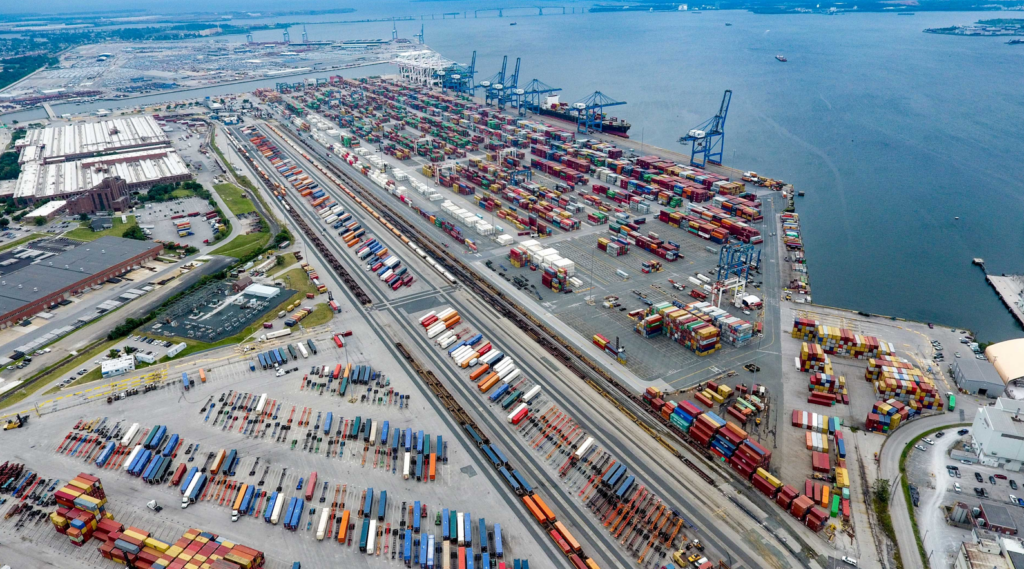
Thinking big: Odyssey’s vision for a tech-enabled future
By Maneet Singh, Chief Information Officer As the initial hype around AI settles into a more measured understanding, the focus shifts to capturing its true
Blog
Explore informative articles, blogs and insights

By Maneet Singh, Chief Information Officer As the initial hype around AI settles into a more measured understanding, the focus shifts to capturing its true

The movement of goods across different transportation modes during a shipment’s journey to its final destination, transloading is a popular choice for companies that want

CVSA’s annual three-day International Roadcheck is scheduled for May 14-16, 2024. The Commercial Vehicle Safety Alliance’s (CVSA) International Roadcheck, the largest enforcement program on commercial

When a massive cargo ship collided with and destroyed Baltimore’s Francis Scott Key Bridge, everyone’s thoughts immediately went to the workers and commuters who may

May 1, 2024 Update Under the Canada Labour Code, April 30 was the last day of the 60-day conciliation period. We now enter a 21-day

A look at the different ways AI and GAI are being used to optimize logistics, transportation and supply chain processes. To say that artificial intelligence

2024 is shaping up to be a rollercoaster for the global supply chain. From Lunar New Year bottlenecks to potential Suez disruptions and the looming

Here are some key trends to watch as we move into 2024 and figure out “what’s next?” for the logistics and transportation networks that keep

Growth is increasing at an increasing rate for Inventory Levels, Inventory Costs, Warehousing Utilization, Warehousing Prices, and Transportation Utilization. Growth is increasing at a decreasing

Operating a successful business hinges on having great employees. So, creating an exceptional employee experience is truly what sets the tone. The reality is that

We need to diversify our sources. The pandemic taught us that it’s not sustainable to have only one place to get critical materials. A resilient

Market recovery in 2023 unlikely. A muted peak import season and lower production in freight-centric sectors, including the manufacturing of paper, wood, plastic, and rubber

If designed and executed properly, sustainability can do more than protect and improve the environment, it can help shippers and carrier partners build stronger, more

For the 2023 Driver’s Appreciation Week, Odyssey Logistics recognizes the efforts of the many dedicated truck drivers who keep the nation’s supply chains in motion

The pandemic tested the resilience of global supply chains — often right up to their breaking point. But the pressures also forced creativity and evolution,

The transport of goods using road, rail, sea and/or air, multimodal shipping is growing in popularity as shippers look for ways to improve the efficiency

All eyes are on sustainability right now as customers, suppliers and other stakeholders expect the companies they work with and/or buy from to implement more

Supply chain visibility – the tracking of in-transit parts, components or products from manufacturer to final destination-, supply chain visibility has long been seen as

For the second time in a row, the Logistics Managers’ Index registers as contracting – coming in at 45.6. This is the fourth consecutive month

Q: What trends are you seeing as the biggest differentiators when it comes to attracting and retaining talent? A: The industry is starting to migrate

There are many unforeseen events that can derail the supply chain. Extreme weather conditions and shifts in carrier capacity are two of the usual culprits.
At Odyssey, we help our customers build more resilient supply chains — end to end. Our managed transportation solutions can be tailored for even the most complex industries.
Explore how we can support the growth goals for your business, so you can navigate today’s evolving supply chain landscape with confidence.
See your impact at Odyssey. Join us as we push the supply chain and logistics industry forward.
Explore corporate and warehouse roles, and driving opportunities with us.
Streamline your supply chain with our resilient transportation solutions, meticulously aligned with your industry’s demands.
When you partner with Odyssey, you benefit from unmatched reliability, expertise and resilience.
| Cookie | Duration | Description |
|---|---|---|
| cookielawinfo-checkbox-advertisement | 1 year | Set by the GDPR Cookie Consent plugin, this cookie records the user consent for the cookies in the "Advertisement" category. |
| cookielawinfo-checkbox-analytics | 11 months | This cookie is set by GDPR Cookie Consent plugin. The cookie is used to store the user consent for the cookies in the category "Analytics". |
| cookielawinfo-checkbox-functional | 11 months | The cookie is set by GDPR cookie consent to record the user consent for the cookies in the category "Functional". |
| cookielawinfo-checkbox-necessary | 11 months | This cookie is set by GDPR Cookie Consent plugin. The cookies is used to store the user consent for the cookies in the category "Necessary". |
| cookielawinfo-checkbox-others | 11 months | This cookie is set by GDPR Cookie Consent plugin. The cookie is used to store the user consent for the cookies in the category "Other. |
| cookielawinfo-checkbox-performance | 11 months | This cookie is set by GDPR Cookie Consent plugin. The cookie is used to store the user consent for the cookies in the category "Performance". |
| CookieLawInfoConsent | 1 year | CookieYes sets this cookie to record the default button state of the corresponding category and the status of CCPA. It works only in coordination with the primary cookie. |
| elementor | never | The website's WordPress theme uses this cookie. It allows the website owner to implement or change the website's content in real-time. |
| viewed_cookie_policy | 11 months | The cookie is set by the GDPR Cookie Consent plugin and is used to store whether or not user has consented to the use of cookies. It does not store any personal data. |
| Cookie | Duration | Description |
|---|---|---|
| __lc_cid | 1 year 1 month 4 days | This is an essential cookie for the website live chat box to function properly. |
| __lc_cst | 1 year 1 month 4 days | This cookie is used for the website live chat box to function properly. |
| __oauth_redirect_detector | 1 minute | This cookie is used to recognize the visitors using live chat at different times inorder to optimize the chat-box functionality. |
| Cookie | Duration | Description |
|---|---|---|
| handlID | 1 month | HandL UTM Grabber plugin sets this cookie to count visits and traffic sources to measure and improve site performance. |
| Cookie | Duration | Description |
|---|---|---|
| _fbp | 3 months | Facebook sets this cookie to display advertisements when either on Facebook or on a digital platform powered by Facebook advertising after visiting the website. |
| _ga | 1 year 1 month 4 days | Google Analytics sets this cookie to calculate visitor, session and campaign data and track site usage for the site's analytics report. The cookie stores information anonymously and assigns a randomly generated number to recognise unique visitors. |
| _ga_* | 1 year 1 month 4 days | Google Analytics sets this cookie to store and count page views. |
| _gcl_au | 3 months | Google Tag Manager sets the cookie to experiment advertisement efficiency of websites using their services. |
| calltrk_session_id | 1 year | This cookie is set by the Provider CallRail. This cookie is used for storing an unique identifier for a user browser session. It is used for tracking the number of phone calls generate from the website. |
| CONSENT | 2 years | YouTube sets this cookie via embedded YouTube videos and registers anonymous statistical data. |
| handl_ref_domain | 1 month | HandL UTM Grabber plugin sets this cookie to contain an ID for referral partners. |
| pardot | past | The pardot cookie is set while the visitor is logged in as a Pardot user. The cookie indicates an active session and is not used for tracking. |
| Cookie | Duration | Description |
|---|---|---|
| calltrk_landing | 6 minutes | This is a functionality cookie set by the CallRail. This cookie is used to store the landing page URL. It helps to accurately attribute the visitor source when displaying a tracking phone number. |
| calltrk_nearest_tld | 1 year 1 month 4 days | This cookie is used for call tracking functionality, set by CallRail. |
| calltrk_referrer | 1 year | This is a functionality cookie set by the CallRail. This cookie is used to store the referring URL. It helps to accurately attribute the visitor source when displaying a tracking phone number. |
| handl_ip | 1 month | HandL UTM Grabber plugin sets this cookie to record the web browser's IP address. |
| handl_landing_page | 1 month | HandL UTM Grabber plugin sets this cookie is used to record the very first page you visited on our site in your browser. |
| handl_original_ref | 1 month | HandL UTM Grabber plugin sets this cookie to record the URL from which you came to our site. |
| handl_ref | 1 month | HandL UTM Grabber plugin sets this cookie to record the URL from which you came to our site. |
| handl_url | 1 month | HandL UTM Grabber plugin sets this cookie to form the URL on which we placed the code that generates. |
| IDE | 1 year 24 days | Google DoubleClick IDE cookies store information about how the user uses the website to present them with relevant ads according to the user profile. |
| NID | 6 months | Google sets the cookie for advertising purposes; to limit the number of times the user sees an ad, to unwanted mute ads, and to measure the effectiveness of ads. |
| test_cookie | 15 minutes | doubleclick.net sets this cookie to determine if the user's browser supports cookies. |
| VISITOR_INFO1_LIVE | 6 months | YouTube sets this cookie to measure bandwidth, determining whether the user gets the new or old player interface. |
| YSC | session | YouTube sets this cookie to track the views of embedded videos on Youtube pages. |
| yt-remote-connected-devices | never | YouTube sets this cookie to store the user's video preferences using embedded YouTube videos. |
| yt-remote-device-id | never | YouTube sets this cookie to store the user's video preferences using embedded YouTube videos. |
| yt.innertube::nextId | never | YouTube sets this cookie to register a unique ID to store data on what videos from YouTube the user has seen. |
| yt.innertube::requests | never | YouTube sets this cookie to register a unique ID to store data on what videos from YouTube the user has seen. |
| Cookie | Duration | Description |
|---|---|---|
| first_traffic_source | 1 month | HandL UTM Grabber plugin sets this cookie to store the visitors' first touch (Paid, Organic, Direct, Referral, Social). |
| handl_landing_page_base | 1 month | HandL UTM Grabber plugin sets this cookie to store the landing page base domain. |
| handl_url_base | 1 month | HandL UTM Grabber plugin sets this cookie to store the base URL only of handl_url. |
| HandLtestDomainName | session | HandL UTM Grabber plugin sets this cookie to automatically get the domain for tracking (via server side). |
| HandLtestDomainNameServer | 1 day | HandL UTM Grabber plugin sets this cookie to automatically get the domain for tracking (via client side). |
| LandingPage | session | HandL UTM Grabber plugin sets this cookie to store the landing page. |
| localTimeZone | session | The cookie is used to store a user's local time zone. |
| organic_source | 1 month | HandL UTM Grabber plugin sets this cookie to record where the visitor came from. |
| organic_source_str | 1 month | HandL UTM Grabber plugin sets this cookie to store the organic source (Google, Bing, Instagram etc). |
| traffic_source | 1 month | HandL UTM Grabber plugin sets this cookie to store the visitors' last touch (Paid, Organic, Direct, Referral, Social). |
| user_agent | session | HandL UTM Grabber plugin sets this cookie to store the user (browser) agent. |
| VISITOR_PRIVACY_METADATA | 6 months | YouTube sets this cookie to estimate the users' bandwidth on pages with integrated YouTube videos. |